Electric Vitamins – One of Physical Essences of Acupuncture Therapy
[i]Authors: Borshchevskaya V.L., Bougrov S.L., Bougrova E.S., Volkov V.V., Pankov S.V., Saltñev S.G., Fedorov S.V., Fedotov V.D.[/i]
Abstract
For many years acupuncture procedures have been successfully applied to clinical practice. However, any universal opinion relative to mechanisms of acupuncture action was not achieved to the present day. Based on experiments carried out by Redox Laboratory, a concept for mechanisms of acupuncture action was proposed. A hypothesis was set up in the study that acupuncture needle, as electron (type 1) conducting electrode, can connect regulatory systems in living organism, as ion (type 2) conductors. Thereby, functional condition in an organism is changed and new regulation level is provided. Besides, the authors consider that signals obtained from acupuncture needle and processed by appropriate modern mathematical analysis tool can be used for diagnostics, primarily in premorbid states.
Keywords: acupuncture, chronopotentiometry, electric vitamins, sympathetic nervous system, parasympathetic nervous system, electrophysiology.
Introduction
At present, according to world and domestic statistical data, significant increase is observed in incidence of essential arterial hypertension [1], ischemic cardiac disease, diabetes mellitus, and several other nosologies, on the ground of metabolic disturbances and regulation disorders at different functional levels. These conditions are similar in their relations to genetical factors [2], and other disturbances caused by life style, social environment, etc. [3]. Besides, an issue is broadly discussed of influence from vegetative nervous system (VNS) on development of these conditions. For example, papers by the Academician A.N. Vein dedicated to VNS research issues, accentuate the most important role of vegetative deregulation in different pathogeneses [4].
Contemporary therapeutic approaches to the above mentioned abnormalities allow in most cases successful achievement of compensated state, but securing prolonged control in every patient seems impossible [5].
In this connection, an interest increases towards complex therapy applying non-medicamentous therapy procedures, particularly needle acupuncture (NAP).
This procedure displays multiple curative properties and, as a result, fixedly occupies one of the leading places in clinical practice [6]. Applying NAP within complex therapy has some expressed influences, such as analgesic, sedative, reparative, metabolic, and several other effects [6].
According to results of multiple experimental and clinical studies, general medicinal and preventive effects of NAP are related to its capacity for adjusting regulation processes in VNS and central nervous system (CNS), and enhancing adaptation responses in organism. In the whole, it may be stated that increasing stress resistance in organism after NAP is a common feature [6].
Despite numerous different theories for NAP action [7, 8, 9], NAP primary action mechanisms, though, at present are still obscure. Our present study was carried out in order to examine details of electrochemical processes during interaction between the needle and the tissue.
Objective: research on mechanism of acupuncture action employing chronopotentiometry of acupuncture needle depending on various external stimuli.
Materials and Methods
Three voluntary subjects were involved in the study: 25 to 30 year males without any acute or exacerbated chronic condition. Any great number of participants was not presumed considering phenomenological nature of the experiment.
Equipment
Equipment was employed in the study, as follows: potentiostate P-30s, acupuncture needles (Redox, Type 2, 0.3 ? 50, gilded) gold-coated, and silver-chloride reference electrode (EVL-1 M3.1). The ice (temperature –4°C) was used as temperature and tactile sensitivity stimulus. 10% aqueous ammonia solution was used as olfactory analyser stimulus. Auditory analyzer was stimulated with shouting or kettle-drum.
Design of Experiment
The study was conducted in spacious room, under dimmed light, at the same time of day.
A subject was placed in relaxed recumbent position and blindfolded. The reference electrode was fixed on forearm inner surface via cotton wool wad soaked with KCl saturated solution.
The physician wearing rubber gloves (hands are insulated from the needle) introduced needles at points He Gu (the palm) and San Yin Jiao (the shin), firstly, in left extremities, and then in right ones. Recording potential on the needle started when the needle touched the skin.
After insertion of needles external stimuli were actuated sequentially and unexpectedly for the subject: loud sound (shout), ice upon belly (10 seconds), loud sound (kettle-drum), wool wad soaked with ammonia drawn near nose (5 seconds).
Change in the potential amplitude (near maximal peak) and time from point of signal deviation from isoline till its returning to isoline were registered during the experiment.
Results and Discussion
Figures 1, 2, and 3 show potential curves, recorded from acupuncture needles. Table 1 presents characteristics of these potentials.
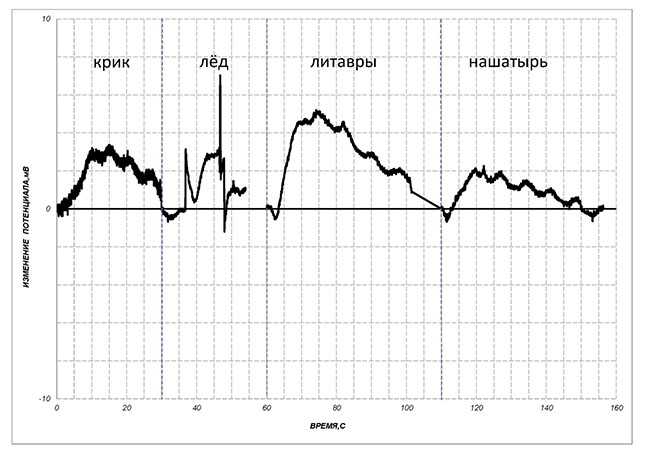 |
| Figure 1. Chronopotentiometry of Acupuncture Needles (Subject No. 1). |
|---|
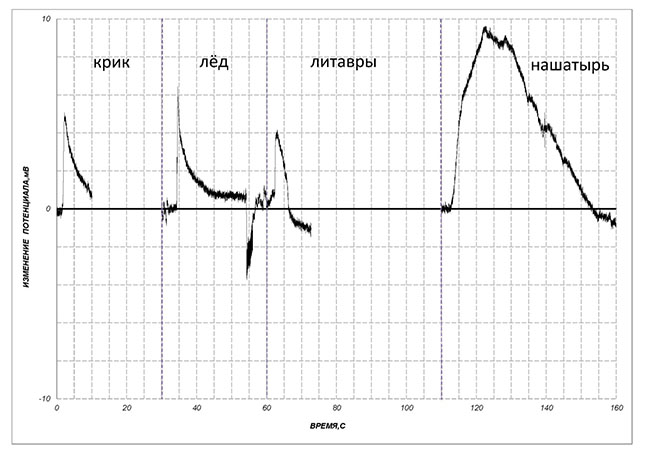 |
| Figure 2. Chronopotentiometry of Acupuncture Needles (Subject No. 2). |
|---|
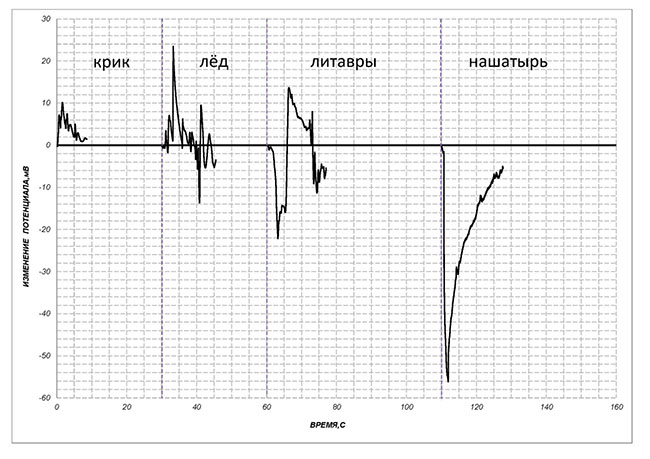 |
| Figure 3. Chronopotentiometry of Acupuncture Needles (Subject No. 3). |
|---|
Table 1. Characteristics of Recorded Potentials, Me [25p; 75p].
| Number of observations, n | Time, s | Amplitude, mV |
|---|---|---|
| 12 | 56 [44; 70] | 6 [4.5; 10] |
Primarily, some apparent similarity of potentials in our experiment to galvanic skin response (GSR) should be noted. GSR, referred to as psychogalvanic reflex, or sympathetic skin reaction in English literature, is also called evoked skin vegetative potential (ESVP) in Russian scientific literature (Figure 4).
The GSR phenomenon, which was first described by Russian physiologist I.R. Tarkhanov, consists in short-time, more or less sharp, reflex change in skin electric conductivity. Nature of this potential is associated with change of skin vessel lumens and action of sweat glands; some of them being innervated by cholinergic sympathetic neural fibres, whereas others by adrenergic ones. It is the latter that largely contribute to GSR formation, as a number of authors suppose [10].
Normal GSR parameters obtained in healthy subjects, according to some other foreign research data are presented in Table 2.
Table 2. Normal GSR Parameters Obtained in Healthy Subjects, According to Kucera [11] and Goizueta-San Marti'n G. [12], M ± ?.
| Number of subjects examined | Upper extremities | Lower extremities | Author |
|---|---|---|---|
| Amplitude (mcV) | Amplitude (mcV) | ||
| 40 | 912.8 ± 605.5 | 480.28 ± 283.82 | Denislic |
| 50 | 678 ± 553 | 268 ± 247 | Aramaki |
| 100 | 449 ± 429 | 147 ± 122 | Drory |
| 30 | 310 ± 180 | 140 ± 80 | Elie |
| 30 | 479 ± 105 | 101 ± 40 | Knezevic |
| 30 | 730 ± 630 | 430 ± 390 | Zgur |
| 45 | 228.1 ± 103.3 | - | Baba |
| 50 | 563 ± 424 | - | Toyokura |
| 35 | 914 ± 372 | 441 ± 214 | Tzeng |
| 32 | 444 ± 167 | 203 ± 87.4 | Kucera |
| 100 | 244 ± 184 | - | Goizueta-San Martín G |
As one can see in Table 2, GSR parameters significantly vary by their amplitudes (200 to 1000 mcV).
In Russian literature a different approach to GSR analysis is adopted (see Figure 4). In particular, intervals of galvanic skin potential phases are considered. Data by S.A. Kotelnikov are presented in Table 3.
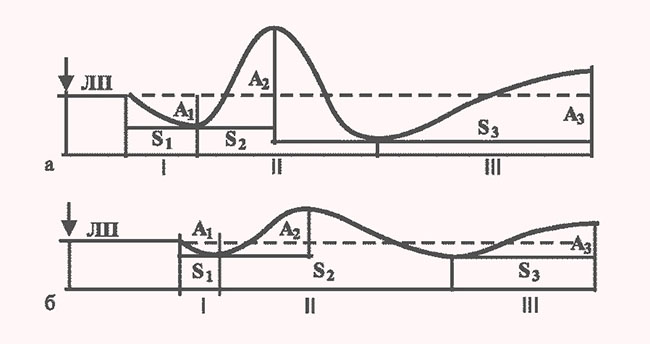 |
| Figure 4. ESVP Parameters: a - ESVP recorded from hand lead; b - ESVP recorded from foot lead. A1 - first phase amplitude, A2 - second phase amplitude, A3 - third phase amplitude; S1 - first phase duration, S2 - second phase duration, S3 - third phase duration [13]. |
|---|
| Parameter | Right palm | Left palm |
|---|---|---|
| A1, mV | 0.45 ± 0.08 | 0.47 ± 0.09 |
| A2, mV | 3.16 ± 0.24 | 3.16 ± 0.35 |
| S1, s | 0.63 ± 0.06 | 0.67 ± 0.09 |
| S2, s | 1.41 ± 0.10 | 1.41 ± 0.15 |
| S3, s | 1.46 ± 0.35 | 5.5 ± 0.48 |
| Parameter | Right sole | Left sole |
| A1, mV | 0.40 ± 0.10 | 0.28 ± 0.08 |
| A2, mV | 1.37 ± 0.26 | 1.40 ± 0.27 |
| S1, s | 0.71 ± 0.12 | 0.68 ± 0.13 |
| S2, s | 1.56 ± 0.17 | 1.55 ± 0.19 |
| S3, s | 8.67 ± 0.92 | 8.33 ± 1.01 |
The amplitude of first phase (A1) is associated with trophotropic centres activity in the hypothalamus, as supposed by Odinak M.M., Shustov, et al. These authors suggest that first phase duration (S1) reflects temporal delay in activating centres, which stimulate perspiration. Parameters of the first phase increase along with activation of trophotropic suprasegmental centres, parasympathicotonia; and decrease along with activation of ergotropic centres, sympathicotonia. The same authors suppose that the amplitude of second phase (A2) reflects activity of suprasegmental (in the first place, hypothalamic) ergotropic centres [14].
At present, GSR (ESVP) interpretation is based on considerations as follows (Figure 5).
Main structures involved in signal processing and GSR formation are represented in the block diagram. It should be noted, that specialised parasympathetic or sympathetic nuclei are not defined in the hypothalamus. Nevertheless, anterior hypothalamus is supposed to be responsible for parasympathetic responses, while posterior hypothalamus is for sympathetic responses. Sweat glands supporting thermoregulation are stimulated by parasympathetic hypothalamic zones (preoptic zone of anterior hypothalamus). Hence, the thermoregulation through perspiration may be regarded as parasympathetic function, despite the fact that it is regulated by neural fibres, which anatomically belong to sympathetic nervous system [14].
So, in accordance with data in Table 1, the potential obtained is inconsistent by its temporal or amplitude characteristics with either GSR, or neuronal action potential, or receptor potential, or motor units [14].
In our case, potentials with greater amplitudes and longer periods were observed, compared to that presented in Table 2 and 3.
We may note that Russian scientists V.G. Vogralik and M.V. Vogralik, and also some researchers abroad, have performed similar experiments, where injury potentials caused by acupuncture needle have been studied [7]. However, potential characteristics obtained there also differ from our findings [7].
In this connection, the following approach is suggested to analysis of response potential peaks recorded during acupuncture needle chronopotentiometry under stimulation with different factors.
It is necessary in first turn to dedicate some words to electrochemical processes occurring at the needle. Being the type 1 conductor, the needle inserted into the medium of different type 2 conductors, connects electrical chain with various electrolytes and supports electrochemical reactions upon itself. One might say that the induced potential wave, which was recorded from the needle, is nothing else, than result of electron transfer between different systems via the needle. We think this would be correctly compared with a similar phenomenon in non-animate nature, namely EMF dropping in an accumulator, when cathode is short cut with anode. It is appropriate to mention here that electromagnetic impulse velocity in metal is some orders higher than neural impulse transmission rate.
In our experiment the needle was inserted into vascularised tissue with both cholinergic, and adrenergic innervations [4]. As it is known, neural endings in skin vessels do not form typical synapses, but they release the mediator relatively far (more than 80 nm) from cells. So, the mediator gets into intercellular space and for some time stays there. Consider, that all biologically active substances being released have various life periods and their effects are continued. Hence, vessel wall smooth-muscle cells are influenced by complex mix of substances as mediators and other vasoactive factors.
Changing vessel lumens due to reflex activation of VNS sympathetic part in response to a stimulus is reflected as the first (ascending) part of potential peak. Then, supposedly, the common result of interaction between mediators, vasoactive factors, and the biological system, is represented by the second part of recorded potential peak, characterized by slow needle potential change.
Hence, the potential recorded from acupuncture needle may be regarded as a compromise index for several processes, as electrochemical interaction between needle and tissue, activity of VNS sympathetic part, and mental and emotional state of the subject.
VNS sympathetic part, most probably, perform needle polarizing function here, featured by quick potential change. This can indicate the level of VNS activity. There are many studies in clinical science dedicated to influence of NAP on functions of VNS sympathetic and parasympathetic parts. All authors agree in opinion that NAP can render beneficial effect on VNS activity by restoring equilibrium between its parts, or in other words eutonia [6, 7].
It is well-known that VNS sympathetic and parasympathetic parts do not relate to each other like scale-beam arms, where upward move of one arm means downward move of another arm. Both subsystems may have high or low tonicity irrespective of another subsystem. Common settings in the whole organism can be observed only under some conditions.
In this connection we would have proposed a model under a conventional name “communicating vessels”, which can describe interrelation between VNS parts. A concept is introduced here of energy and information exchange channel between its parts, which takes into account the state of connection tube. The action of connection tube has a decisive importance in our model, since the tube may exist in three states: cut-off state, when no flow of “liquid” particles occurs, i.e. no exchange takes place; partially-open state, when exchange is weak between communicating vessels, and response will develop slowly; and wide-open state indicated by quick response. Hence, its state largely defines interaction rate between the two subsystems.
An appropriate question is put farther: how this connection can be influenced upon? Both VNS parts have their own afferent and efferent systems, but their effects are realised in close interaction; connections between VNS sympathetic and parasympathetic parts are regulated by central divisions of the nervous system.
We suppose that electron stream flowing through acupuncture needle may exert influence upon interaction between two these subsystems, and can be proposed for this role. We may assume that after insertion of needle into tissue a new “regulation contour” in body is formed, since the needle, the tissue, VNS subsystems, and CNS become organised within the common interaction complex. Beneficial changes being observed in an organism during NAP treatment can be explained by this “integration effect” of acupuncture needle.
The recorded curves allow a suggestion that acupuncture needle chronopotentiometry can be of some diagnostic value, e.g. for characteristics of body regulatory systems state, and showing presence or absence of any overstress.
In order to describe such an interaction and the resulting effect we have suggested the term “Electric Vitamins”. The Electric Vitamins is an electrical current, which can be generated and consumed in human body during interaction with metals and other low-resistivity conductors. The electrical current can be produced by thermo-EMF [15], biopotential differences, piezo-EMF, galvanic effect, and, as in our example of acupuncture needle, the disbalance between sympathetic and parasympathetic subsystems.
Conclusion
The electrophysiology has gathered a wealth of experience in studying relations between living body and metals. The issue relates, primarily, electrocardiography, electroencephalography, and other non-invasive electrophysiological diagnostics procedures.
But options for invasive electrophysiological diagnostics procedures are rather poor. None of them has gained any wide recognition.
It should be also stressed here that not all existing diagnostic procedures, even more advanced ones, are able to reveal any abnormal process at early stage, but only when obvious symptoms already appear.
Thus, the procedure proposed has a number of advantages before standard GSR assessment procedure. Though our procedure is an invasive one, on the one hand, hazard of infectious complications is extremely low here; on the other hand, the procedure is remarkable for greater sensitivity and information. This can provide greater capability in premorbid diagnostics of abnormalities, mainly concerned with irregular life-style and impact of stressing factors. Returning to possible side-effects, low bad-case statistics accompanying NAP or needle functional electroneuromyography may be cited here.
Application of the procedure for evaluating NAP therapy, or pharmacological therapy being conducted, is also possible. E.g.: choice of hypotensive drugs, and so on.
Small number of observations and suddenness in applying stimuli may be regarded as disadvantages of our study.
Nevertheless, this procedure is promising by our opinion, and worthy for farther development.
The model of interaction between body systems and acupuncture needle is proposed on Figure 6.
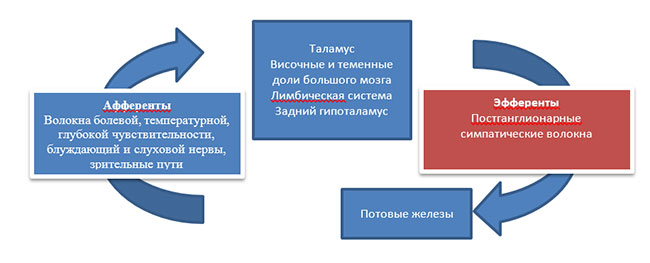 |
| Figure 5. Block Diagram of GSR. |
|---|
In conclusion, we wish to express the following. The contemporary life raises new challenges of growing complexity before the human. Despite all advances in the medical science, premorbid diagnostics issue becomes sharper. In this context, some good habits may and should take a function of timely premorbid state diagnostics. Needle acupuncture, formatted as a pleasure, may potentially become a new good habit.
Literature References
- Stevens, G. Global health risks: progress and challenges. / G. Stevens, M. Mascarenhas, C. Mathers // Bulletin of the World Health Organization. - 2009. - Vol. 87. - p. 646.
- The genetic response to short-term interventions affecting cardiovascular functions: Rationale and design of the HAPI Heart Study. / B.D. Mitchell [et al.] // Am. Heart J. - 2008. - Vol. 155. - p. 823-828. 118.
- Rare independent mutations in renal salt handling genes contribute to blood pressure variation. / W. Ji [et al.] // Nat. Genet. - 2008. - Vol. 40. - p. 592-599.
- Vegetative disturbances: Clinics, therapy, and diagnostics. / A.M. Vein, ed. - Moscow: Medical Information Agency, 2000. -p. 752
- Jones, Daniel W. Hypertension: Pathways to Success. / Daniel W. Jones, John E. Hall // Hypertension. - 2008. - Vol. 51. - p. 1249-1251.
- Belousova, T.E. Clinical principle in restorative reflexotherapy. / T.E. Belousova // Reflexotherapy and manual therapy in the XXI century: Proceedings of the International Congress. - Moscow, 2006. - p. 31-32.
- Vogralik, V.G. Puncture reflexotherapy: Ñhen-chiu. / V.G. Vogralik, M.V. Vogralik. - Gorky: Volgo-Vyatskoye Publishing House, 1988 - ð. 335.
- Vasilenko, A.M. Elements of modern reflexotherapy theory. / A.M. Vasilenko // - Reflexotherapy. - 2002. - No. 3. - p. 28-37.
- Ivanichev, G.A. Sensory and reflex interaction in acupuncture mechanisms. / G.A. Ivanichev, Kazan. - 1999. - p. 142.
- Sukhodoev, V.V. Methodical grounds for measurements, analysis and applying parameters of galvanic skin response in human. / Issues in professional activity: theory and methods for psychological analysis. M., 1999, p. 303-353.
- Sympathetic skin response: review of the method. / Kucera P [et al.] // Bratisl. Lek. Listy. - 2004. - No. 3. - Vol. 105. - p. 108 - 116.
- Sympathetic skin response: reference data for 100 normal subjects. / Goizueta-San Mart?n G. [et al.] // Rev. Neurol. - 2013. - No. 6. - Vol 56. - p. 321-326.
- Kotelnikov, S.A. Evoked skin vegetative potentials (contemporary conceptions on their mechanisms). / S.A. Kotelnikov [et al.] // Human Physiology - 2000. - V. 26, No. 5. - p. 79-91.
- Odinak, M.M. Diseases and injuries of peripheral nervous system (summary of clinical and experimental practice). / M.M. Odinak, S.A. Zhivolupov. - Saint-Petersburg: "SpetcLit", 2009. - p. 384.
- Bougrov, S.L. Gymnastics with natural redox currents - a new useful habit. / S.L. Bougrov, O.N. Goutkina, U.Y. Rouzhentsova // The Bulletin of European Postgraduate Centre of Acupuncture and Homeopathy. - 2000. - No. 4. - p. 170.
All information of a section «2014»